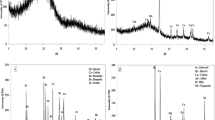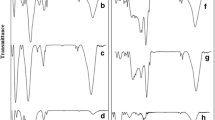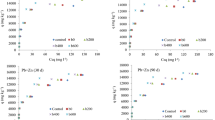Abstract
Two laboratory experiments were conducted to evaluate micronutrient adsorption efficiency by different rice husk biochar types (RHB-350, RHB-450, RHB-550, and RHB-650) and evaluate the availability of these nutrients in calcareous sandy soil treated with feedstock- and biochar-loaded micronutrients. Adsorption kinetic experiments of multi-metal ions (Zn2+, Cu2+, Mn2+, and Fe2+) were conducted using 1000, 100, 500, and 1000 µg g−1 biochar, respectively. In the incubation experiment, the four micronutrients were loaded on feedstock (F +) and RHB-450 (B +). The blank-non-loaded-micronutrients of feedstock (F-) or RHB-450 (B-) and loaded-micronutrients (F + or B +) were applied to soil (2.5 and 5%) and incubated for 60 days (≃30 °C) in two-factor completely randomized design. Kinetic experiment showed that RHB-450 could be effectively used to retain Zn2+ (86.38%), Cu2+ (87.61%), Mn2+ (76.26%), and Fe2+ (65.90%) in multi-metal-ions systems. The adsorption kinetic is well described using the pseudo-second order model (R2, 0.999–1.000), which refers to chemical adsorption. In the incubation experiment, the highest release of the investigated micronutrients occurred during the 16-day incubation of soil treated with loaded micronutrients. Moreover, 5% (F +) had the highest values (P < 0.05) for Zn2+ and Fe2+ bioavailability, while Mn2+ was the highest at 5% (B-). Interaction effects showed the highest significance of Cu2+ and Mn2+ bioavailability at 32-day incubation for 5% F- and B-, respectively, while Zn2+ and Fe2+ were found for 5% F + treatment at 16- and 64-day incubation, respectively. Biochar is better for loading micronutrients than feedstock, but feedstock loaded-micronutrients is more efficient for increasing micronutrients bioavailability in calcareous sandy soil.






Similar content being viewed by others
References
Abdel-Ghani NT, El-Chaghaby GA, Zahran EM (2015) Cost effective adsorption of aluminum and iron from synthetic and real wastewater by rice hull activated carbon (RHAC). Am J Anal Chem 6:71–83. https://doi.org/10.4236/ajac.2015.61007
Barnes RT, Gallagher ME, Masiello CA, Liu Z, Dugan B (2014) Biochar-induced changes in soil hydraulic conductivity and dissolved nutrient fluxes constrained by laboratory experiments. PLoS One 9: e108340 https://doi.org/10.1371/journal.pone.0108340.
Chatterjee R, Sajjadi B, Chen W-Y, Mattern DL, Hammer N, Raman V, Dorris A (2020) Effect of pyrolysis temperature on physicochemical properties and acoustic-based amination of biochar for efficient CO2 adsorption. Front Energy Res 8:85. https://doi.org/10.3389/fenrg.2020.00085
Claoston N, Samsuri AW, Ahmad Husni MH, Mohd Amran MS (2014) Effects of pyrolysis temperature on the physicochemical properties of empty fruit bunch and rice husk biochars. Waste Manag Res 32:331–339. https://doi.org/10.1177/0734242X14525822
El-Gamal EH, Saleh M, Elsokkary I, Rashad M, Abd El-Latif MM (2017) Comparison between properties of biochar produced by traditional and controlled pyrolysis. Alexandria Sci Exch J 38:412–425 https://doi.org/10.21608/asejaiqjsae.2017.3720
Elhafez SE, Hamad HA, Zaatout AA, Malash GF (2017) Management of agricultural waste for removal of heavy metals from aqueous solution: adsorption behaviors, adsorption mechanisms, environmental protection, and techno-economic analysis. Environ Sci Pollut Res 24:1397–1415. https://doi.org/10.1007/s11356-016-7891-7
Enaime G, Baçaoui A, Yaacoubi A, Lübken M (2020) Biochar for wastewater treatment-conversion technologies and applications. Appl Sci 10:3492. https://doi.org/10.3390/app10103492
Farkas É, Feigl V, Gruiz K, Vaszita E, Fekete-Kertész I, Tolner M, Kerekes I, Pusztai É, Kari A, Uzinger N, Rékási M, Kirchkeszner C, Molnár M (2020) Long-term effects of grain husk and paper fibre sludge biochar on acidic and calcareous sandy soils – a scale-up field experiment applying a complex monitoring toolkit. Sci Total Environ 731:138988 https://doi.org/10.1016/j.scitotenv.2020.138988
Forbes MS, Raison RJ, Skjemstad JO (2006) Formation, transformation and transport of black carbon (charcoal) in terrestrial and aquatic ecosystems. Sci Total Environ 370:190–206. https://doi.org/10.1016/j.scitotenv.2006.06.007
Gaskin J, Steiner C, Harris K, Das K, Bibens B (2008) Effect of low-temperature pyrolysis conditions on biochar for agricultural use. Trans ASABE 51:2061–2069 https://doi.org/10.13031/2013.25409
Gwenzi W, Nyambishi TJ, Chaukura N, Mapope N (2018) Synthesis and nutrient release patterns of a biochar-based N-P–K slow-release fertilizer. Int J Environ Sci Technol 15:405–414. https://doi.org/10.1007/S13762-017-1399-7
Hossain MZ, Bahar MM, Sarkar B, Donne SW, Ok YS, Palansooriya KN, Kirkham MB, Chowdhury S, Bolan N (2020) Biochar and its importance on nutrient dynamics in soil and plant. Biochar 2:379–420. https://doi.org/10.1007/S42773-020-00065-Z
Ippolito JA, Stromberger ME, Lentz RD, Dungan RS (2016) Hardwood biochar and manure co-application to a calcareous soil. Chemosphere 142:84–91. https://doi.org/10.1016/j.chemosphere.2015.05.039
Jalali M, Moradi F (2013) Competitive sorption of Cd, Cu, Mn, Ni, Pb and Zn in polluted and unpolluted calcareous soils. Environ Monit Assess 185:8831–8846. https://doi.org/10.1007/S10661-013-3216-1
Jindo K, Mizumoto H, Sawada Y, Sanchez-Monedero MA, Sonoki T (2014) Physical and chemical characterization of biochars derived from different agricultural residues. Biogeosciences 11:6613–6621. https://doi.org/10.5194/bg-11-6613-2014
Jones JB, Case VW (1990) Sampling, handling, and analyzing plant tissue samples. In: Westerman RL (ed) Soil testing and plant analysis, 3rd edn., Soil Sci Soc Am, USA, pp 389–427 https://doi.org/10.2136/sssabookser3.3ed.c15
Lehmann J, Gaunt J, Rondon M (2006) Bio-char sequestration in terrestrial ecosystems – a review. Mitig Adapt Strateg Glob Chang 11:403–427. https://doi.org/10.1007/S11027-005-9006-5
Lindsay WL, Norvell WA (1978) Development of a DTPA soil test for zinc, iron, manganese, and copper. Soil Sci Soc Am J 42:421–428. https://doi.org/10.2136/sssaj1978.03615995004200030009x
Masulili A, Utomo WH, MS S (2010) Rice husk biochar for rice based cropping system in acid soil 1. The characteristics of rice husk biochar and its influence on the properties of acid sulfate soils and rice growth in West Kalimantan, Indonesia. J Agric Sci 2:39-47https://doi.org/10.5539/jas.v2n1p39
Nanda S, Dalai AK, Berruti F, Kozinski JA (2016) Biochar as an exceptional bioresource for energy, agronomy, carbon sequestration, activated carbon and specialty materials. Waste Biomass Valor 7:201–235. https://doi.org/10.1007/s12649-015-9459-z
Nelson DW, Sommers LE (1996) Total carbon, organic carbon, and organic matter. In: Sparks DL, Page AL, Helmke PA, Loeppert RH, Soltanpour PN, Tabatabai MA, Johnston CT, Sumner ME (ed) Methods of soil analysis, part 3: chemical methods, Soil Sci Soc Am, Wiley, USA, pp 961–1010 https://doi.org/10.2136/sssabookser5.3.c34
Novak JM, Busscher WJ, Watts DW, Amonette JE, Ippolito JA, Lima IM, Gaskin J, Das KC, Steiner C, Ahmedna M, Rehrah D, Schomberg H (2012) Biochars impact on soil-moisture storage in an ultisol and two aridisols. Soil Sci 177:310–320. https://doi.org/10.1097/ss.0b013e31824e5593
Novotny EH, Maia CMB de F, Carvalho MT de M, Madari BE (2015) Biochar: pyrogenic carbon for agricultural use - a critical review. Rev Bras Ciência do Solo 39:321–344https://doi.org/10.1590/01000683rbcs20140818
Osman KT (2018) Sandy soils. In: Management of soil problems. Springer International Publishing, Cham, pp 37–65 https://doi.org/10.1007/978-3-319-75527-4_1
Page AL, Miller RH, Keeney DR, Baker DE, Jr RE, Rhoades JD, Dinauer RC, Gates KE (1982) Methods of soil analysis part 2, second edition. In: Methods of soil analysis, chemical and microbiological properties, Agron. Monograph, no 2. ASA- Soil Sci Soc Am., Madison, WI, USA
Park M, Komarneni S (1998) Rapid synthesis of AlPO4-11 and cloverite by microwavehydrothermal processing. Microporous Mesoporous Mater 20:39–44. https://doi.org/10.1016/s1387-1811(97)00007-3
Prakongkep N, Gilkes RJ, Wiriyakitnateekul W, Duangchan A (2013) The effects of pyrolysis conditions on the chemical and physical properties of rice husk biochar. Int J Mater Sci 3:97–103
Rafiq MK, Bachmann RT, Rafiq MT, Shang Z, Joseph S, Long R (2016) Influence of pyrolysis temperature on physico-chemical properties of corn stover (Zea mays L.) biochar and feasibility for carbon capture and energy balance. PLoS One 11:e0156894 https://doi.org/10.1371/journal.pone.0156894
Saleh ME, El-Damarawy YA, Assad FF, Abdelsalam AA, Yousef RA (2020a) Removal of copper metal ions by sugarcane bagasse and rice husk biochars from contaminated aqueous solutions. Mediterr J Soil Sci 1:1–17
Saleh ME, El-Gamal EH, Kamh MA (2020b) Effect of dissolved organic compounds of some agricultural residues on sorption kinetic of zinc by synthetic carbonate minerals. Mediterr J Soil Sci 1:57–70
Sedláková M, Száková J, Lhotka M, Hailegnaw NS, Holečková Z, Pračke K, Robledo-Mahón T, Tlustoš P (2021) Changes in soil carbon and nitrogen accessibility with the application of biochars with different morphological and physical characteristics. J Soils Sediments 21:1644–1658. https://doi.org/10.1007/S11368-021-02910-5
Shi J, Fan X, Tsang DCW, Wang F, Shen Z, Hou D, Alessi DS (2019) Removal of lead by rice husk biochars produced at different temperatures and implications for their environmental utilizations. Chemosphere 235:825–831. https://doi.org/10.1016/j.chemosphere.2019.06.237
Soil Survey Staff (2014) Keys to soil taxonomy, 12th edn. USDA Natural Resources Conservation Service, Washington, DC
Srivastava VC, Mall ID, Mishra IM (2009) Competitive adsorption of cadmium(II) and nickel(II) metal ions from aqueous solution onto rice husk ash. Chem Eng Process 48:370–379. https://doi.org/10.1016/j.cep.2008.05.001
Taalab AS, Ageeb GW, Siam HS, Mahmoud SA (2019) Some characteristics of calcareous soils. A review. Middle East J Agric Res 8:96–105
Tomczyk A, Sokołowska Z, Boguta P (2020) Biochar physicochemical properties: pyrolysis temperature and feedstock kind effects. Rev Environ Sci Bio/technol 19:191–215. https://doi.org/10.1007/s11157-020-09523-3
Tsai W-T, Lin Y-Q, Huang H-J (2021) Valorization of rice husk for the production of porous biochar materials. Ferment Artic 7:1–12. https://doi.org/10.3390/fermentation7020070
Wahba MM, Labib F, Zaghloul A (2019) Management of calcareous soils in arid region. Int J Environm Pollut Environ Model 2:248–258
Wang L, Bolan NS, Tsang DCW, Hou D (2020) Green immobilization of toxic metals using alkaline enhanced rice husk biochar: effects of pyrolysis temperature and KOH concentration. Sci Total Environ 720:137584 https://doi.org/10.1016/j.scitotenv.2020.137584
Waseem M, Mustafa S, Naeem A, Koper GJM, Salahud D (2010) Physiochemical properties of mixed oxides of iron and silicon. J Non-Cryst Solids 356:2704–2708. https://doi.org/10.1016/j.jnoncrysol.2010.09.055
Wu H, Che X, Ding Z, Hu X, Creamer AE, Chen H, Gao B (2016) Release of soluble elements from biochars derived from various biomass feedstocks. Environ Sci Pollut Res 23:1905–1915. https://doi.org/10.1007/s11356-015-5451-1/tables/3
Xu Y, Chen B (2015) Organic carbon and inorganic silicon speciation in rice-bran-derived biochars affect its capacity to adsorb cadmium in solution. J Soils Sediment 15:60–70. https://doi.org/10.1007/s11368-014-0969-2
Yang X, Wan Y, Zheng Y, He F, Yu Z, Huang J, Wang H, Ok YS, Jiang Y, Gao B (2019) Surface functional groups of carbon-based adsorbents and their roles in the removal of heavy metals from aqueous solutions: a critical review. Chem Eng J 366:608–621. https://doi.org/10.1016/j.cej.2019.02.119
Yost JL, Hartemink AE (2019) Soil organic carbon in sandy soils: a review. Adv Agron 158:217–310. https://doi.org/10.1016/BS.AGRON.2019.07.004
Zhang H, Voroney RP, Price GW (2015) Effects of temperature and processing conditions on biochar chemical properties and their influence on soil C and N transformations. Soil Biol Biochem 83:19–28. https://doi.org/10.1016/j.soilbio.2015.01.006
Zhao Y, Zhao L, Mei Y, Li F, Cao X (2018) Release of nutrients and heavy metals from biochar-amended soil under environmentally relevant conditions. Env Sci Pollut Res 25:2517–2527. https://doi.org/10.1007/s11356-017-0668-9
Author information
Authors and Affiliations
Corresponding author
Ethics declarations
Conflict of Interest
The authors declare no competing interests.
Additional information
Publisher's Note
Springer Nature remains neutral with regard to jurisdictional claims in published maps and institutional affiliations.
Rights and permissions
Springer Nature or its licensor (e.g. a society or other partner) holds exclusive rights to this article under a publishing agreement with the author(s) or other rightsholder(s); author self-archiving of the accepted manuscript version of this article is solely governed by the terms of such publishing agreement and applicable law.
About this article
Cite this article
El-Gamal, E.H., Salem, L.R., Mahmoud, A.H. et al. Evaluation of Rice Husk Biochar as a Micronutrients Carrier on Micronutrients Availability in a Calcareous Sandy Soil. J Soil Sci Plant Nutr 23, 1633–1647 (2023). https://doi.org/10.1007/s42729-023-01184-9
Received:
Accepted:
Published:
Issue Date:
DOI: https://doi.org/10.1007/s42729-023-01184-9




